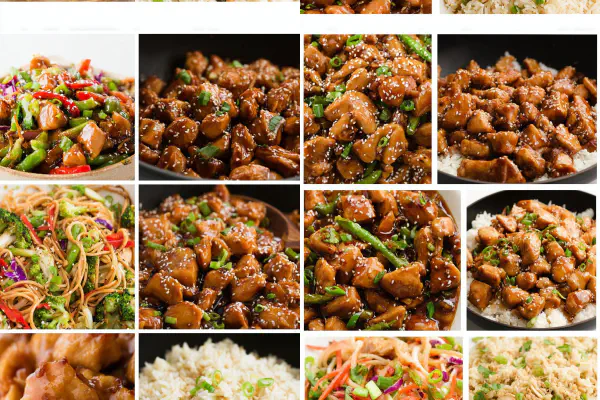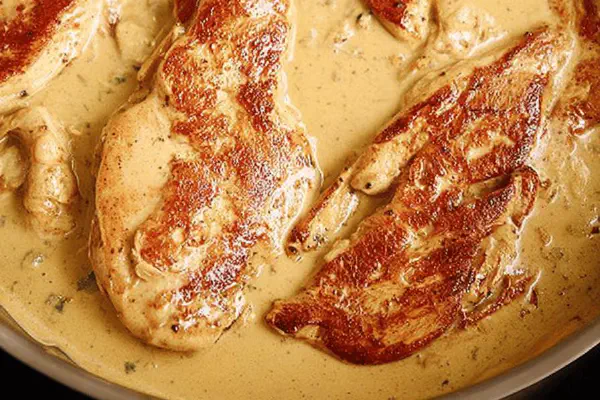Sticky Sesame Chicken

By Emma
Certified Culinary Professional
Ingredients
- 2 chicken breasts, cut into bite-sized pieces
- 1 1/4 tbsp cornstarch, divided
- 1 1/2 tbsp sesame oil
- 1/2 tsp black pepper
- 1/2 tsp onion powder
- 1/2 cup freshly squeezed orange juice (sub for apple juice)
- 3 tbsp tomato ketchup
- 3 tbsp soy sauce (adjust for sodium)
- 1/4 cup water
- 2 tbsp brown sugar
- 1/2 tsp ground ginger
- 2 cloves garlic, minced
- Optional garnish: sliced scallions or sesame seeds
- Serve with steamed white rice
About the ingredients
Method
- Pat chicken pieces dry, then toss with 1 tbsp cornstarch for initial coating. Dry chicken is key for that golden crust, otherwise it'll steam and get soggy.
- Heat sesame oil over medium in a large skillet till barely shimmering, add chicken spread out. Let it sit without moving for a couple minutes. You want that bottom crust to crisp like a sear on a steak.
- Flip and stir till no longer pink. Drain off excess juices to avoid boiling. Slide chicken to edges; cook a little longer, listen for the sizzle pop crackle of browning bits forming on the bottom of the pan—this is flavor gold.
- Mix black pepper, onion powder, orange juice, ketchup, soy sauce, 1/4 cup water, brown sugar, ground ginger, minced garlic, and 1/4 tsp of cornstarch in a bowl. Whisk till smooth; the cornstarch here thickens the sauce when simmered.
- Pour sauce into skillet. Use a wooden spoon to scrape up browned bits—that fond lifts the sauce from good to great. Bring to a rolling boil to wake up spices and sugars, aroma will fill the kitchen with a tangy sweet punch.
- Lower heat to a gentle simmer. Stir often, sauce bubbles gently around chicken, thickens, coats. About 6-8 minutes but watch thickness by sauce's cling to chicken and glossy sheen. If too thin, add a dash more cornstarch water slurry.
- Turn off stove. Let sit 4-5 minutes. The residual heat finishes thickening without overcooking chicken. Sauce deepens in flavor, texture turns gluey sticky—perfect for spooning over rice.
- Serve chicken spooned over steaming white rice. Garnish with sliced scallions or sprinkle toasted sesame seeds if feeling fancy. Taste for salt and acidity; adjust with splash soy or lime juice if needed.
Cooking tips
Chef's notes
- 💡 Pat chicken very dry or crust fails. Toss with cornstarch after drying. Too wet equals steaming, soggy edges. Cornstarch split—1 tbsp for coating, 1/4 tsp mixed in sauce—adds crisp plus thickens sauce afloat simmer.
- 💡 Heat sesame oil medium but watch for shimmer not smoke. Oil too cool and chicken sticks, not browns. Too hot burns fond. That sizzle pop crackle heard? Golden crust starts. Let chicken sit still few minutes. No stirring allowed early or no crust forms.
- 💡 Drain liquids after initial cook. If juices stay, pan steams chicken, kills crust. Slide chicken to edges before sauce pour. Sauce scrapes pan bottom, lifts dark browned bits—the fond. Big flavor locked here. Don’t skip stirring in sauce to grab fond.
- 💡 Simmer sauce slow after boil. Rolling boil ramps up spices fast but burns sugars and garlic bitterness creeps. Watch sauce bubble gently. Coats with glossy sheen means almost done. Add cornstarch slurry very gradually if sauce too thin. Avoid clumps by whisking before pouring.
- 💡 Rest sauce off heat 4-5 minutes. Residual warmth thickens sauce more without cooking chicken further. Sticky glaze forms, clings better to rice. Salt tricky: soy sauce can be salty; dilute with water or low sodium. Orange juice brighter than apple juice but if missing, switch back. Ketchup unique - tomato paste plus sugar and vinegar barely hits same combo.
Common questions
How to keep chicken crispy?
Dry chicken heavily before coating cornstarch. Wet chicken steams no crust. Heat oil right. Let chicken settle without stirring till crisp bottom forms. Drain excess juice or pan steams chicken. That sizzle noise is key indicator to flip.
Can orange juice be replaced?
Apple juice swap fine but flavor changes. Orange juice brighter, citrus punch cuts sweet brown sugar bass tones. No juice? Use water but sauce loses some brightness. Ketchup unique in tang and sweetness; tomato paste plus sugar and cider vinegar can mimic but less balanced.
Sauce too thin or runny?
Mix cornstarch slurry slowly, add bit at a time. Sauce bubbles gently. Too hot or fast boiling burns sugars, makes bitter. Resting sauce thickens by itself. Thick coating means ready. No spoonful stick means add slurry or more simmer time.
How to store leftovers?
Cool fully before refrigerating. Sauce thickens and gels cold, reheat gently with splash water to loosen. Microwave or stove on low heat. Can freeze but texture of chicken softens. Best eaten within 2 days refrigerated to keep some crisp texture if reheated.



